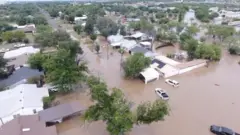Texas Flood Tragedy: Unpacking the Early Warnings and Preparedness Amidst Devastation
Devastating flash floods have ravaged central Texas, claiming the lives of nearly 80 individuals, including 28 children. The most severe impact was felt in Kerr County, where a girls’ camp was tragically inundated. Rescue operations are still underway, and authorities anticipate the death toll will continue to rise as the full extent of the disaster becomes clear.
As the community grapples with this immense loss, critical questions are emerging regarding the adequacy of flood warnings and the timeliness of evacuations. Many are questioning whether residents were sufficiently alerted to the impending danger posed by the unprecedented rainfall and rapid rise of the Guadalupe River.

Kerr County Judge Rob Kelly stated that the ferocity of the flooding was entirely unexpected, remarking, “We had no reason to believe that this was gonna be any, anything like what’s happened here. None whatsoever.” This sentiment highlights the catastrophic nature of the event, which saw the Guadalupe River swell by an astonishing 26 feet in just 45 minutes, overwhelming its banks.
Timing of Flood Warnings
The sequence of events leading up to the disaster has come under scrutiny. While the Texas Division of Emergency Management (TDEM) had activated state emergency response resources on Wednesday due to “increased threats of flooding,” specific warnings for the Kerr County area were issued later.
- A Flood Watch, highlighting Kerr County as an area at high risk of flash flooding overnight, was issued by the National Weather Service (NWS) on Thursday afternoon.
- Subsequently, a Flash Flood Warning was issued for Kerr County at 01:14 local time (06:14 GMT) on Friday.
- Further warnings, including an emergency flash flood warning for Kerr County and another for the Guadalupe River, were issued at 04:03 and 05:34 local time respectively.
Preparedness and Communication Challenges
Governor Greg Abbott noted that while Texans are accustomed to flash flood warnings, the sheer scale of this event—a “water wall of almost 30ft high”—was beyond typical expectations. Concerns have also been raised about communication infrastructure in affected areas. Nim Kidd, chief of the Texas Division of Emergency Management, pointed out that in regions with limited or no cell phone coverage, even robust alert systems may fail to reach residents.
The practicality of a county-administered warning system, akin to a tornado siren, was previously considered by Kerr County about six years ago. However, due to the significant cost involved, such a system was never implemented, a decision that now prompts difficult questions in the wake of the tragedy.
The NWS defended its actions, stating, “On July 3, the NWS office in Austin/San Antonio, TX conducted forecast briefings for emergency management in the morning and issued a Flood Watch in the early afternoon. Flash Flood Warnings were issued on the night of July 3 and in the early morning of July 4, giving preliminary lead times of more than three hours before warning criteria were met.” Experts have suggested that the forecasts were as accurate as possible given the extreme and rapidly escalating nature of the storm.
Impact of Budget Cuts on Weather Services
Questions have also surfaced regarding the potential impact of budget cuts on the National Weather Service (NWS) and its parent agency, the National Oceanic and Atmospheric Administration (NOAA). Reports indicate that previous budget considerations included cuts to research laboratories and a reduction in staffing. Meteorologists have voiced concerns that a decrease in the release of weather balloons, crucial for gathering atmospheric data, could affect forecasting accuracy.
While some reports suggested potential impacts from staff shortages, others countered that the NWS offices responsible for the affected region were adequately staffed during the event. In fact, the National Weather Service office covering central Texas reportedly had five staff members on duty, exceeding the usual number of two.
Government Response and Technological Upgrades
In response to the disaster and concerns about preparedness, U.S. Homeland Security Secretary Kristi Noem acknowledged the inherent difficulty in predicting weather events. She assured that the current administration is prioritizing the modernization of the weather warning system, which has been “neglected for far too long.” Secretary Noem committed to conveying the public’s concerns about warning lead times back to the federal government, emphasizing that upgrading technology is a key focus to enhance future preparedness.



Post Comment